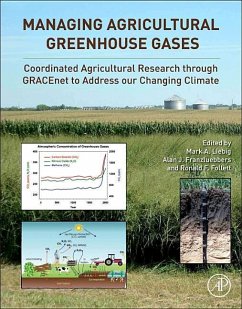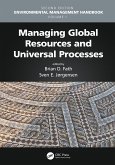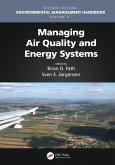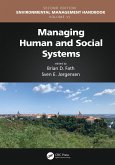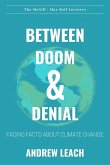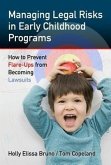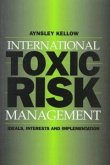Managing Agricultural Greenhouse Gases
Coordinated Agricultural Research Through Gracenet to Address Our Changing Climate
Herausgeber: Liebig, Mark; Follett, Ronald F; Franzluebbers, A J
Managing Agricultural Greenhouse Gases
Coordinated Agricultural Research Through Gracenet to Address Our Changing Climate
Herausgeber: Liebig, Mark; Follett, Ronald F; Franzluebbers, A J
- Broschiertes Buch
- Merkliste
- Auf die Merkliste
- Bewerten Bewerten
- Teilen
- Produkt teilen
- Produkterinnerung
- Produkterinnerung
Global climate change is a natural process that currently appears to be strongly influenced by human activities, which increase atmospheric concentrations of greenhouse gases (GHG). Agriculture contributes about 20% of the world's global radiation forcing from carbon dioxide, methane and nitrous oxide, and produces 50% of the methane and 70% of the nitrous oxide of the human-induced emission. Managing Agricultural Greenhouse Gases synthesizes the wealth of information generated from the GRACEnet (Greenhouse gas Reduction through Agricultural Carbon Enhancement network) effort with contributors…mehr
Andere Kunden interessierten sich auch für
![Managing Fear Managing Fear]() Bernadette McsherryManaging Fear252,99 €
Bernadette McsherryManaging Fear252,99 €![Managing Global Resources and Universal Processes Managing Global Resources and Universal Processes]() Managing Global Resources and Universal Processes52,99 €
Managing Global Resources and Universal Processes52,99 €![Managing Air Quality and Energy Systems Managing Air Quality and Energy Systems]() Managing Air Quality and Energy Systems94,99 €
Managing Air Quality and Energy Systems94,99 €![Managing Human and Social Systems Managing Human and Social Systems]() Managing Human and Social Systems52,99 €
Managing Human and Social Systems52,99 €![Between Doom & Denial Between Doom & Denial]() Andrew LeachBetween Doom & Denial19,99 €
Andrew LeachBetween Doom & Denial19,99 €![Managing Legal Risks in Early Childhood Programs Managing Legal Risks in Early Childhood Programs]() Holly Elissa BrunoManaging Legal Risks in Early Childhood Programs39,99 €
Holly Elissa BrunoManaging Legal Risks in Early Childhood Programs39,99 €![International Toxic Risk Management International Toxic Risk Management]() Aynsley KellowInternational Toxic Risk Management44,99 €
Aynsley KellowInternational Toxic Risk Management44,99 €-
-
-
Global climate change is a natural process that currently appears to be strongly influenced by human activities, which increase atmospheric concentrations of greenhouse gases (GHG). Agriculture contributes about 20% of the world's global radiation forcing from carbon dioxide, methane and nitrous oxide, and produces 50% of the methane and 70% of the nitrous oxide of the human-induced emission. Managing Agricultural Greenhouse Gases synthesizes the wealth of information generated from the GRACEnet (Greenhouse gas Reduction through Agricultural Carbon Enhancement network) effort with contributors from a variety of backgrounds, and reports findings with important international applications.
Hinweis: Dieser Artikel kann nur an eine deutsche Lieferadresse ausgeliefert werden.
Hinweis: Dieser Artikel kann nur an eine deutsche Lieferadresse ausgeliefert werden.
Produktdetails
- Produktdetails
- Verlag: Elsevier Science
- Seitenzahl: 536
- Erscheinungstermin: 1. Juni 2012
- Englisch
- Gewicht: 450g
- ISBN-13: 9781493301263
- ISBN-10: 1493301268
- Artikelnr.: 41640755
- Herstellerkennzeichnung
- Libri GmbH
- Europaallee 1
- 36244 Bad Hersfeld
- gpsr@libri.de
- Verlag: Elsevier Science
- Seitenzahl: 536
- Erscheinungstermin: 1. Juni 2012
- Englisch
- Gewicht: 450g
- ISBN-13: 9781493301263
- ISBN-10: 1493301268
- Artikelnr.: 41640755
- Herstellerkennzeichnung
- Libri GmbH
- Europaallee 1
- 36244 Bad Hersfeld
- gpsr@libri.de
Section One: Agricultural Research for a Carbon-Constrained World
1. Agriculture and climate change: Mitigation opportunities and
adaptation imperatives (Mark A. Liebig, Alan J. Franzluebbers, and
Ron F. Follett)
2. GRACEnet: Addressing policy needs through coordinated cross-location
research (Charles L. Walthall, Steven R. Shafer, and Michael D.
Jawson)
Section Two: Agricultural Management and Soil Carbon Dynamics
3. Cropland management in the eastern United States for improved soil
organic C sequestration (Curtis J. Dell and Jeffrey M. Novak)
4. Soil carbon sequestration in central USA agroecosystems (Cynthia A.
Cambardella, Jane M. F. Johnson, and Gary E. Varvel
5. Agricultural management and soil carbon dynamics: Western U.S.
croplands (Harold P. Collins, Maysoon M. Mikha, Tabitha T. Brown,
Jeffrey L. Smith, David Huggins, and Upendra M. Sainju)
6. Soil carbon dynamics and rangeland management (Justin D. Derner and
Virginia L. Jin)
7. Soil organic carbon under pasture management (Alan J. Franzluebbers,
Lloyd B. Owens, Gilbert C. Sigua, Cynthia A. Cambardella, and Richard
L. Haney)
8. Sustainable bioenergy feedstock production systems: Integrating C
dynamics, erosion, water quality and greenhouse gas production (Jane
M. F. Johnson and Jeffrey M. Novak)
Section Three: Agricultural Management and Greenhouse Gas Flux
9. Cropland management contributions to GHG flux: Central and eastern
U.S. (Michel A. Cavigelli and Timothy B. Parkin)
10. Management to reduce greenhouse gas emissions in western U.S.
croplands (Ardell D. Halvorson, Kerri L. Steenwerth, Emma C. Suddick,
Mark A. Liebig, Jeffery L. Smith, Kevin F. Bronson, and Harold P.
Collins)
11. Greenhouse gas flux from managed grasslands in the U.S. (Mark A.
Liebig, Xuejun Dong, Jean E.T. McLain, and Curtis J. Dell)
12. Mitigation opportunities for life cycle greenhouse gas emissions
during feedstock production across heterogeneous landscapes (Paul R.
Adler, Stephen J. Del Grosso, Daniel Inman, Robin E. Jenkins, Sabrina
Spatari, and Yimin Zhang)
13. Greenhouse gas fluxes of drained organic and flooded mineral
agricultural soils in the United States (Leon Hartwell Allen, Jr.)
Section Four: Model Simulations for Estimating Soil Carbon Dynamics
and Greenhouse Gas Flux from Agricultural Production Systems
14. DayCent model simulations for estimating soil carbon dynamics and
greenhouse gas fluxes from agricultural production systems (Stephen
J. Del Grosso, William J. Parton, Paul R. Adler, Sarah C. Davis,
Cindy Keough, and Ernest Marx)
15. COMET2.0 - Decision support system for agricultural greenhouse gas
accounting (Keith Paustian, Jill Schuler, Kendrick Killian, Adam
Chambers, Steven DelGrosso, Mark Easter, Jorge Alvaro-Fuentes, Ram
Gurung, Greg Johnson, Miles Merwin, Stephen Ogle, Carolyn Olson, Amy
Swan, Steve Williams, and Roel Vining)
16. CQESTR simulations of soil organic carbon dynamics (H.T. Gollany, R.
F. Follett, and Y. Liang)
17. Development and application of the EPIC model for carbon cycle,
greenhouse-gas mitigation, and biofuel studies (R.C. Izaurralde, W.B.
McGill, and J.R. Williams)
18. The general ensemble biogeochemical modeling system (GEMS) and its
applications to agricultural systems in the United States (Shuguang
Liu, Zhengxi Tan, Mingshi Chen, Jinxun Liu, Anne Wein, Zhengpeng Li,
Shengli Huang, Jennifer Oeding, Claudia Young, Shashi B. Verma,
Andrew E. Suyker, Stephen Faulkner, and Gregory W. McCarty)
Section Five: Measurements and Monitoring: Improving Estimates of
Soil Carbon Dynamics and Greenhouse Gas Flux
19. Quantifying biases in non-steady state chamber measurements of
soil-atmosphere gas exchange (Rodney T. Venterea and Timothy B.
Parkin)
20. Advances in spectroscopic methods for quantifying soil carbon (James
B Reeves, III, Gregory W. McCarty, Francisco Calderon, and W. Dean
Hively)
21. Micrometeorological methods for assessing greenhouse gas flux (R.
Howard Skinner and Claudia Wagner-Riddle)
22. Remote sensing of soil carbon and greenhouse gas dynamics across
agricultural landscapes (C.S.T. Daughtry, E.R. Hunt Jr., P.C. Beeson,
S. Milak, M.W. Lang, G. Serbin, J.G. Alfieri, G.W. McCarty, and A.M.
Sadeghi)
Section Six: Economic and Policy Considerations Associated with
Reducing Net Greenhouse Gas Emissions from Agriculture
23. Economic outcomes of greenhouse gas mitigation options (David W.
Archer and Lyubov A. Kurkalova)
24. Agricultural greenhouse gas trading markets in North America (D.C.
Reicosky, T. Goddard, D. Enerson, A.S.K. Chan, and M.A. Liebig)
25. Eligibility criteria affecting landowner participation in greenhouse
gas programs (Robert Johansson, Greg Latta, Eric White, Jan
Lewandrowski, and Ralph Alig)
Section Seven: Looking Ahead: Opportunities for Future Research and
Collaboration
26. Potential GRACEnet linkages with other greenhouse gas and soil carbon
research and monitoring programs (John M. Baker and Ronald F.
Follett)
27. Elevated CO2 and warming effects on soil carbon sequestration and
greenhouse gas exchange in agroecosystems: A review (Feike A.
Dijkstra and Jack A. Morgan)
28. Mitigation opportunities from land management practices in a warming
world: Increasing potential sinks (J.L. Hatfield, T.B. Parkin, T.J.
Sauer, and J.H. Prueger)
29. Beyond mitigation: Adaptation of agricultural strategies to overcome
projected climate change (Ronald F. Follett)
1. Agriculture and climate change: Mitigation opportunities and
adaptation imperatives (Mark A. Liebig, Alan J. Franzluebbers, and
Ron F. Follett)
2. GRACEnet: Addressing policy needs through coordinated cross-location
research (Charles L. Walthall, Steven R. Shafer, and Michael D.
Jawson)
Section Two: Agricultural Management and Soil Carbon Dynamics
3. Cropland management in the eastern United States for improved soil
organic C sequestration (Curtis J. Dell and Jeffrey M. Novak)
4. Soil carbon sequestration in central USA agroecosystems (Cynthia A.
Cambardella, Jane M. F. Johnson, and Gary E. Varvel
5. Agricultural management and soil carbon dynamics: Western U.S.
croplands (Harold P. Collins, Maysoon M. Mikha, Tabitha T. Brown,
Jeffrey L. Smith, David Huggins, and Upendra M. Sainju)
6. Soil carbon dynamics and rangeland management (Justin D. Derner and
Virginia L. Jin)
7. Soil organic carbon under pasture management (Alan J. Franzluebbers,
Lloyd B. Owens, Gilbert C. Sigua, Cynthia A. Cambardella, and Richard
L. Haney)
8. Sustainable bioenergy feedstock production systems: Integrating C
dynamics, erosion, water quality and greenhouse gas production (Jane
M. F. Johnson and Jeffrey M. Novak)
Section Three: Agricultural Management and Greenhouse Gas Flux
9. Cropland management contributions to GHG flux: Central and eastern
U.S. (Michel A. Cavigelli and Timothy B. Parkin)
10. Management to reduce greenhouse gas emissions in western U.S.
croplands (Ardell D. Halvorson, Kerri L. Steenwerth, Emma C. Suddick,
Mark A. Liebig, Jeffery L. Smith, Kevin F. Bronson, and Harold P.
Collins)
11. Greenhouse gas flux from managed grasslands in the U.S. (Mark A.
Liebig, Xuejun Dong, Jean E.T. McLain, and Curtis J. Dell)
12. Mitigation opportunities for life cycle greenhouse gas emissions
during feedstock production across heterogeneous landscapes (Paul R.
Adler, Stephen J. Del Grosso, Daniel Inman, Robin E. Jenkins, Sabrina
Spatari, and Yimin Zhang)
13. Greenhouse gas fluxes of drained organic and flooded mineral
agricultural soils in the United States (Leon Hartwell Allen, Jr.)
Section Four: Model Simulations for Estimating Soil Carbon Dynamics
and Greenhouse Gas Flux from Agricultural Production Systems
14. DayCent model simulations for estimating soil carbon dynamics and
greenhouse gas fluxes from agricultural production systems (Stephen
J. Del Grosso, William J. Parton, Paul R. Adler, Sarah C. Davis,
Cindy Keough, and Ernest Marx)
15. COMET2.0 - Decision support system for agricultural greenhouse gas
accounting (Keith Paustian, Jill Schuler, Kendrick Killian, Adam
Chambers, Steven DelGrosso, Mark Easter, Jorge Alvaro-Fuentes, Ram
Gurung, Greg Johnson, Miles Merwin, Stephen Ogle, Carolyn Olson, Amy
Swan, Steve Williams, and Roel Vining)
16. CQESTR simulations of soil organic carbon dynamics (H.T. Gollany, R.
F. Follett, and Y. Liang)
17. Development and application of the EPIC model for carbon cycle,
greenhouse-gas mitigation, and biofuel studies (R.C. Izaurralde, W.B.
McGill, and J.R. Williams)
18. The general ensemble biogeochemical modeling system (GEMS) and its
applications to agricultural systems in the United States (Shuguang
Liu, Zhengxi Tan, Mingshi Chen, Jinxun Liu, Anne Wein, Zhengpeng Li,
Shengli Huang, Jennifer Oeding, Claudia Young, Shashi B. Verma,
Andrew E. Suyker, Stephen Faulkner, and Gregory W. McCarty)
Section Five: Measurements and Monitoring: Improving Estimates of
Soil Carbon Dynamics and Greenhouse Gas Flux
19. Quantifying biases in non-steady state chamber measurements of
soil-atmosphere gas exchange (Rodney T. Venterea and Timothy B.
Parkin)
20. Advances in spectroscopic methods for quantifying soil carbon (James
B Reeves, III, Gregory W. McCarty, Francisco Calderon, and W. Dean
Hively)
21. Micrometeorological methods for assessing greenhouse gas flux (R.
Howard Skinner and Claudia Wagner-Riddle)
22. Remote sensing of soil carbon and greenhouse gas dynamics across
agricultural landscapes (C.S.T. Daughtry, E.R. Hunt Jr., P.C. Beeson,
S. Milak, M.W. Lang, G. Serbin, J.G. Alfieri, G.W. McCarty, and A.M.
Sadeghi)
Section Six: Economic and Policy Considerations Associated with
Reducing Net Greenhouse Gas Emissions from Agriculture
23. Economic outcomes of greenhouse gas mitigation options (David W.
Archer and Lyubov A. Kurkalova)
24. Agricultural greenhouse gas trading markets in North America (D.C.
Reicosky, T. Goddard, D. Enerson, A.S.K. Chan, and M.A. Liebig)
25. Eligibility criteria affecting landowner participation in greenhouse
gas programs (Robert Johansson, Greg Latta, Eric White, Jan
Lewandrowski, and Ralph Alig)
Section Seven: Looking Ahead: Opportunities for Future Research and
Collaboration
26. Potential GRACEnet linkages with other greenhouse gas and soil carbon
research and monitoring programs (John M. Baker and Ronald F.
Follett)
27. Elevated CO2 and warming effects on soil carbon sequestration and
greenhouse gas exchange in agroecosystems: A review (Feike A.
Dijkstra and Jack A. Morgan)
28. Mitigation opportunities from land management practices in a warming
world: Increasing potential sinks (J.L. Hatfield, T.B. Parkin, T.J.
Sauer, and J.H. Prueger)
29. Beyond mitigation: Adaptation of agricultural strategies to overcome
projected climate change (Ronald F. Follett)
Section One: Agricultural Research for a Carbon-Constrained World
1. Agriculture and climate change: Mitigation opportunities and
adaptation imperatives (Mark A. Liebig, Alan J. Franzluebbers, and
Ron F. Follett)
2. GRACEnet: Addressing policy needs through coordinated cross-location
research (Charles L. Walthall, Steven R. Shafer, and Michael D.
Jawson)
Section Two: Agricultural Management and Soil Carbon Dynamics
3. Cropland management in the eastern United States for improved soil
organic C sequestration (Curtis J. Dell and Jeffrey M. Novak)
4. Soil carbon sequestration in central USA agroecosystems (Cynthia A.
Cambardella, Jane M. F. Johnson, and Gary E. Varvel
5. Agricultural management and soil carbon dynamics: Western U.S.
croplands (Harold P. Collins, Maysoon M. Mikha, Tabitha T. Brown,
Jeffrey L. Smith, David Huggins, and Upendra M. Sainju)
6. Soil carbon dynamics and rangeland management (Justin D. Derner and
Virginia L. Jin)
7. Soil organic carbon under pasture management (Alan J. Franzluebbers,
Lloyd B. Owens, Gilbert C. Sigua, Cynthia A. Cambardella, and Richard
L. Haney)
8. Sustainable bioenergy feedstock production systems: Integrating C
dynamics, erosion, water quality and greenhouse gas production (Jane
M. F. Johnson and Jeffrey M. Novak)
Section Three: Agricultural Management and Greenhouse Gas Flux
9. Cropland management contributions to GHG flux: Central and eastern
U.S. (Michel A. Cavigelli and Timothy B. Parkin)
10. Management to reduce greenhouse gas emissions in western U.S.
croplands (Ardell D. Halvorson, Kerri L. Steenwerth, Emma C. Suddick,
Mark A. Liebig, Jeffery L. Smith, Kevin F. Bronson, and Harold P.
Collins)
11. Greenhouse gas flux from managed grasslands in the U.S. (Mark A.
Liebig, Xuejun Dong, Jean E.T. McLain, and Curtis J. Dell)
12. Mitigation opportunities for life cycle greenhouse gas emissions
during feedstock production across heterogeneous landscapes (Paul R.
Adler, Stephen J. Del Grosso, Daniel Inman, Robin E. Jenkins, Sabrina
Spatari, and Yimin Zhang)
13. Greenhouse gas fluxes of drained organic and flooded mineral
agricultural soils in the United States (Leon Hartwell Allen, Jr.)
Section Four: Model Simulations for Estimating Soil Carbon Dynamics
and Greenhouse Gas Flux from Agricultural Production Systems
14. DayCent model simulations for estimating soil carbon dynamics and
greenhouse gas fluxes from agricultural production systems (Stephen
J. Del Grosso, William J. Parton, Paul R. Adler, Sarah C. Davis,
Cindy Keough, and Ernest Marx)
15. COMET2.0 - Decision support system for agricultural greenhouse gas
accounting (Keith Paustian, Jill Schuler, Kendrick Killian, Adam
Chambers, Steven DelGrosso, Mark Easter, Jorge Alvaro-Fuentes, Ram
Gurung, Greg Johnson, Miles Merwin, Stephen Ogle, Carolyn Olson, Amy
Swan, Steve Williams, and Roel Vining)
16. CQESTR simulations of soil organic carbon dynamics (H.T. Gollany, R.
F. Follett, and Y. Liang)
17. Development and application of the EPIC model for carbon cycle,
greenhouse-gas mitigation, and biofuel studies (R.C. Izaurralde, W.B.
McGill, and J.R. Williams)
18. The general ensemble biogeochemical modeling system (GEMS) and its
applications to agricultural systems in the United States (Shuguang
Liu, Zhengxi Tan, Mingshi Chen, Jinxun Liu, Anne Wein, Zhengpeng Li,
Shengli Huang, Jennifer Oeding, Claudia Young, Shashi B. Verma,
Andrew E. Suyker, Stephen Faulkner, and Gregory W. McCarty)
Section Five: Measurements and Monitoring: Improving Estimates of
Soil Carbon Dynamics and Greenhouse Gas Flux
19. Quantifying biases in non-steady state chamber measurements of
soil-atmosphere gas exchange (Rodney T. Venterea and Timothy B.
Parkin)
20. Advances in spectroscopic methods for quantifying soil carbon (James
B Reeves, III, Gregory W. McCarty, Francisco Calderon, and W. Dean
Hively)
21. Micrometeorological methods for assessing greenhouse gas flux (R.
Howard Skinner and Claudia Wagner-Riddle)
22. Remote sensing of soil carbon and greenhouse gas dynamics across
agricultural landscapes (C.S.T. Daughtry, E.R. Hunt Jr., P.C. Beeson,
S. Milak, M.W. Lang, G. Serbin, J.G. Alfieri, G.W. McCarty, and A.M.
Sadeghi)
Section Six: Economic and Policy Considerations Associated with
Reducing Net Greenhouse Gas Emissions from Agriculture
23. Economic outcomes of greenhouse gas mitigation options (David W.
Archer and Lyubov A. Kurkalova)
24. Agricultural greenhouse gas trading markets in North America (D.C.
Reicosky, T. Goddard, D. Enerson, A.S.K. Chan, and M.A. Liebig)
25. Eligibility criteria affecting landowner participation in greenhouse
gas programs (Robert Johansson, Greg Latta, Eric White, Jan
Lewandrowski, and Ralph Alig)
Section Seven: Looking Ahead: Opportunities for Future Research and
Collaboration
26. Potential GRACEnet linkages with other greenhouse gas and soil carbon
research and monitoring programs (John M. Baker and Ronald F.
Follett)
27. Elevated CO2 and warming effects on soil carbon sequestration and
greenhouse gas exchange in agroecosystems: A review (Feike A.
Dijkstra and Jack A. Morgan)
28. Mitigation opportunities from land management practices in a warming
world: Increasing potential sinks (J.L. Hatfield, T.B. Parkin, T.J.
Sauer, and J.H. Prueger)
29. Beyond mitigation: Adaptation of agricultural strategies to overcome
projected climate change (Ronald F. Follett)
1. Agriculture and climate change: Mitigation opportunities and
adaptation imperatives (Mark A. Liebig, Alan J. Franzluebbers, and
Ron F. Follett)
2. GRACEnet: Addressing policy needs through coordinated cross-location
research (Charles L. Walthall, Steven R. Shafer, and Michael D.
Jawson)
Section Two: Agricultural Management and Soil Carbon Dynamics
3. Cropland management in the eastern United States for improved soil
organic C sequestration (Curtis J. Dell and Jeffrey M. Novak)
4. Soil carbon sequestration in central USA agroecosystems (Cynthia A.
Cambardella, Jane M. F. Johnson, and Gary E. Varvel
5. Agricultural management and soil carbon dynamics: Western U.S.
croplands (Harold P. Collins, Maysoon M. Mikha, Tabitha T. Brown,
Jeffrey L. Smith, David Huggins, and Upendra M. Sainju)
6. Soil carbon dynamics and rangeland management (Justin D. Derner and
Virginia L. Jin)
7. Soil organic carbon under pasture management (Alan J. Franzluebbers,
Lloyd B. Owens, Gilbert C. Sigua, Cynthia A. Cambardella, and Richard
L. Haney)
8. Sustainable bioenergy feedstock production systems: Integrating C
dynamics, erosion, water quality and greenhouse gas production (Jane
M. F. Johnson and Jeffrey M. Novak)
Section Three: Agricultural Management and Greenhouse Gas Flux
9. Cropland management contributions to GHG flux: Central and eastern
U.S. (Michel A. Cavigelli and Timothy B. Parkin)
10. Management to reduce greenhouse gas emissions in western U.S.
croplands (Ardell D. Halvorson, Kerri L. Steenwerth, Emma C. Suddick,
Mark A. Liebig, Jeffery L. Smith, Kevin F. Bronson, and Harold P.
Collins)
11. Greenhouse gas flux from managed grasslands in the U.S. (Mark A.
Liebig, Xuejun Dong, Jean E.T. McLain, and Curtis J. Dell)
12. Mitigation opportunities for life cycle greenhouse gas emissions
during feedstock production across heterogeneous landscapes (Paul R.
Adler, Stephen J. Del Grosso, Daniel Inman, Robin E. Jenkins, Sabrina
Spatari, and Yimin Zhang)
13. Greenhouse gas fluxes of drained organic and flooded mineral
agricultural soils in the United States (Leon Hartwell Allen, Jr.)
Section Four: Model Simulations for Estimating Soil Carbon Dynamics
and Greenhouse Gas Flux from Agricultural Production Systems
14. DayCent model simulations for estimating soil carbon dynamics and
greenhouse gas fluxes from agricultural production systems (Stephen
J. Del Grosso, William J. Parton, Paul R. Adler, Sarah C. Davis,
Cindy Keough, and Ernest Marx)
15. COMET2.0 - Decision support system for agricultural greenhouse gas
accounting (Keith Paustian, Jill Schuler, Kendrick Killian, Adam
Chambers, Steven DelGrosso, Mark Easter, Jorge Alvaro-Fuentes, Ram
Gurung, Greg Johnson, Miles Merwin, Stephen Ogle, Carolyn Olson, Amy
Swan, Steve Williams, and Roel Vining)
16. CQESTR simulations of soil organic carbon dynamics (H.T. Gollany, R.
F. Follett, and Y. Liang)
17. Development and application of the EPIC model for carbon cycle,
greenhouse-gas mitigation, and biofuel studies (R.C. Izaurralde, W.B.
McGill, and J.R. Williams)
18. The general ensemble biogeochemical modeling system (GEMS) and its
applications to agricultural systems in the United States (Shuguang
Liu, Zhengxi Tan, Mingshi Chen, Jinxun Liu, Anne Wein, Zhengpeng Li,
Shengli Huang, Jennifer Oeding, Claudia Young, Shashi B. Verma,
Andrew E. Suyker, Stephen Faulkner, and Gregory W. McCarty)
Section Five: Measurements and Monitoring: Improving Estimates of
Soil Carbon Dynamics and Greenhouse Gas Flux
19. Quantifying biases in non-steady state chamber measurements of
soil-atmosphere gas exchange (Rodney T. Venterea and Timothy B.
Parkin)
20. Advances in spectroscopic methods for quantifying soil carbon (James
B Reeves, III, Gregory W. McCarty, Francisco Calderon, and W. Dean
Hively)
21. Micrometeorological methods for assessing greenhouse gas flux (R.
Howard Skinner and Claudia Wagner-Riddle)
22. Remote sensing of soil carbon and greenhouse gas dynamics across
agricultural landscapes (C.S.T. Daughtry, E.R. Hunt Jr., P.C. Beeson,
S. Milak, M.W. Lang, G. Serbin, J.G. Alfieri, G.W. McCarty, and A.M.
Sadeghi)
Section Six: Economic and Policy Considerations Associated with
Reducing Net Greenhouse Gas Emissions from Agriculture
23. Economic outcomes of greenhouse gas mitigation options (David W.
Archer and Lyubov A. Kurkalova)
24. Agricultural greenhouse gas trading markets in North America (D.C.
Reicosky, T. Goddard, D. Enerson, A.S.K. Chan, and M.A. Liebig)
25. Eligibility criteria affecting landowner participation in greenhouse
gas programs (Robert Johansson, Greg Latta, Eric White, Jan
Lewandrowski, and Ralph Alig)
Section Seven: Looking Ahead: Opportunities for Future Research and
Collaboration
26. Potential GRACEnet linkages with other greenhouse gas and soil carbon
research and monitoring programs (John M. Baker and Ronald F.
Follett)
27. Elevated CO2 and warming effects on soil carbon sequestration and
greenhouse gas exchange in agroecosystems: A review (Feike A.
Dijkstra and Jack A. Morgan)
28. Mitigation opportunities from land management practices in a warming
world: Increasing potential sinks (J.L. Hatfield, T.B. Parkin, T.J.
Sauer, and J.H. Prueger)
29. Beyond mitigation: Adaptation of agricultural strategies to overcome
projected climate change (Ronald F. Follett)

